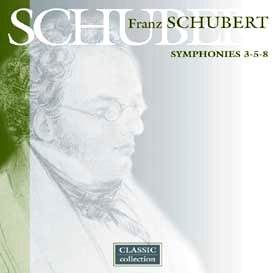During his short lifetime Schubert’s reputation as
a composer rested mainly on his Lieder – over 400 of them –
and the popular dance suites for piano. The chamber works, piano sonatas,
operas and symphonies were admired by Viennese cognoscenti, but virtually
ignored elsewhere, and there were few, if any, public performances.
Mendelssohn conducted the Symphony No.9, the Great C Major, in Leipzig
in 1839 but, with the exception of No.8, the complete cycle did not
reach the European concert repertoire until the mid 20th
century, and even then infrequently.
The three Symphonies on this disc are all Viennese
in character, and their fluent, song-like nature is well-served by the
light textures and brisk tempi adopted by the Hannover Band, giving
these performances a freshness and spontaneity that make them distinctively
Schubertian. The two marvellous movements of No. 8 immediately establish
what makes these readings revelatory. The Band is fully equal to the
drama of the first movement and the tender melancholy of the second,
without the Sachertort sweetness that mars less acceptable interpretations.
I find it difficult to believe that even Schubert (who was not given
to brevity) would have wished to add another note to the abandoned commission
now known as his ‘Unfinished’ Symphony
Tempo markings for all three works are on the fast
side – andante con moto for the second movements of Nos.8 and
5, allegro molto, allegro vivace, allegro con brio, allegro vivace,
vivace, and presto vivace for movements in 5 and 3 – and
leave little doubt that Schubert was usually looking for a lively
approach. In this recording, he gets it, together with a the delightful
detail and spirited playing so clearly required – a tribute to
Goodman and his Band, and an example to those who take a more superficial
view.
After its Beethovenian opening No. 3, composed in the
same year as No.2 when Schubert was 18, is obviously a precocious work,
owing much to the Viennese taste for cheerful, foot-tapping tunes; yet
the young composer’s craftsmanship is remarkably confident and, as played
on this disc, no apology is needed for its appearance in the company
of its more mature companions.
By their use of smaller-than-usual orchestral forces
and meticulous attention to tempo and dynamic markings these can fairly
be called ‘historically informed’ performances – a term not always
so well deserved. The CD case states Licensed from Nimbus UK,
and contains neither an insert booklet nor details of when and where
the recording was made, a small but irritating omission.
Roy Brewer

![]() The Hanover Band/Roy
Goodman
The Hanover Band/Roy
Goodman ![]() CLASSIC COLLECTION 99877
[74.18]
CLASSIC COLLECTION 99877
[74.18]